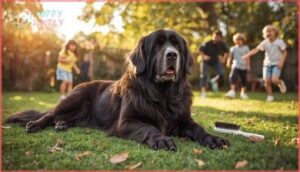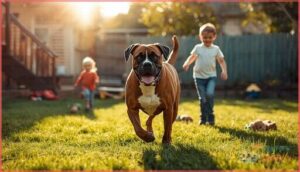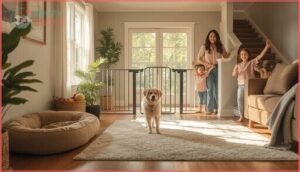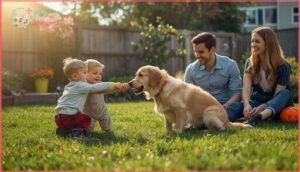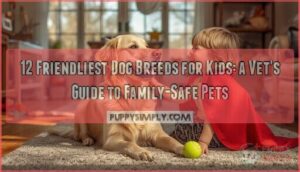This site is supported by our readers. We may earn a commission, at no cost to you, if you purchase through links.
The right dog can turn a noisy house into a warm, wagging sanctuary—laughter spills a little easier, sticky fingers find soft fur, and childhood memories come with a pair of floppy ears.
But not every breed matches the whirlwind pace and gentle chaos of life with young children. Picking the perfect companion takes more than a fondness for puppy-dog eyes; it calls for a blend of patience, playfulness, and that innate knack for understanding both silly games and quiet moments.
The best dog breeds for families with young children bring more than company—they knit safety and joy into every day.
Table Of Contents
- Key Takeaways
- Key Traits of Family-Friendly Dog Breeds
- Top Large Dog Breeds for Young Children
- Best Medium Dog Breeds for Families
- Small Dog Breeds Suited for Kids
- Dog Breeds for Families With Allergies
- Breeds to Avoid With Young Children
- Preparing Your Home for a New Family Dog
- Training and Socialization for Family Dogs
- Frequently Asked Questions (FAQs)
- What is the most kid friendly dog in the world?
- What is the best dog for a family with young children?
- What is the best dog to have with babies?
- What is the number one family dog?
- What health issues are common in family?
- How do you introduce a new dog to toddlers?
- What dog breeds are hypoallergenic for families?
- How can we ensure a dog is socialized?
- Are rescue dogs suitable for young families?
- What is the typical lifespan of family dog breeds?
- Conclusion
Key Takeaways
- The best dogs for families with young children are gentle, patient, adaptable, and easy to train, with breeds like Labradors, Golden Retrievers, and Beagles standing out.
- Medium and small breeds like Beagles, Collies, Poodles, and Boston Terriers offer a good balance of playfulness, safety, and manageable care for busy households.
- Hypoallergenic breeds such as Poodles and their mixes, along with regular grooming, can help families with allergy concerns enjoy life with a dog.
- Avoid breeds with high energy, strong prey drives, or sensitivity to noise, and focus on positive training, careful socialization, and supervised child-dog interactions for a safe, happy home.
Key Traits of Family-Friendly Dog Breeds
When you’re searching for a family dog, a few key qualities can make all the difference. Think about how a dog fits into your daily life and the needs of your kids. Here are the main things that matter most.
Temperament and Patience
Temperament can be the anchor in your search for Family Friendly Dogs. Gentle Souls like Golden Retrievers and Labradors shine here, with a soft temperament and impressive patience.
Calm Nature and Emotional Intelligence matter most, especially in Child Friendly Breeds. Patient breeds with low reactivity set the stage for safe, harmonious connections between children and dogs.
Understanding the theme development process is essential for identifying the best breeds.
Energy Level and Playfulness
While a gentle spirit helps, you’ll notice Dog Behavior and Temperament shine brightest during play. Family Friendly Dogs match your pace, balancing Playful Traits and manageable Energy Needs.
Breeds for Kids like Labradors or Beagles thrive with Daily Exercise and Family Activities, making them Pet Compatibility stars. Their playful yet steady approach keeps everyone—from toddlers to teens—smiling together.
Understanding a topic’s main subtopics is essential for providing detailed information.
Size and Adaptability
Matching your family’s lifestyle sometimes comes down to Size and Adaptability. Think about how space requirements mesh with breed adaptability—bigger breeds may need a yard and structured Dog Enrichment, while smaller Child Friendly Pets might settle into cozier homes.
For families, balancing household safety and active family dynamics helps guarantee Dog Breeds for Families become everyone’s reliable companion.
Trainability and Intelligence
Once you find a breed that fits your space, it’s smart to look for Cognitive Abilities and Learning Speed in your next companion. Intelligent Breeds make parenting easier by picking up basics and thriving in Dog Training and Behavior routines. Trainable Dogs often display:
- Fast Problem Solving
- Attention to routines
- Adaptable Dog Temperament
- Reliable recall with Trainability Tips
Top Large Dog Breeds for Young Children
Some large breeds are especially well-suited to families with young children. They’re known for patience, gentleness, and a love of play.
Here’s a look at four favorites that stand out for all the right reasons.
Labrador Retriever
Have you ever seen a dog light up a backyard like it’s their own playground? The Labrador Retriever brings warmth, patience, and boundless energy to any family mix.
Their easy-going dog temperament, love of play, and quick learning make them one of the most child-friendly dog breeds—ideal for families dedicated to Labrador care and positive puppy socialization.
Golden Retriever
A Golden Retriever ushers kindness and patience straight into your home. With a history rooted in gentle, eager-to-please companionship, this breed is famous for Family Bonding and child-friendly instincts.
Prioritizing Golden Care, Retriever Health, and Dog Nutrition ensures your Golden remains a healthy, loyal friend—making them a standout in Family Pet Choices for families seeking kid-friendly animals and Family Friendly Dog Breeds.
Newfoundland
Gentle Giants like the Newfoundland set a high bar for Child-Friendly Dogs—think sturdy patience, soft mouths, and loyal Family Companions. With strong Trainability Tips and an 85% owner rating in ease of learning, they suit families with room to spare.
Newfoundland Care means frequent grooming, attention to joint health, and embracing one of the best Family Pet Choices among Large Breed Needs.
Boxer
Looking for a spark of playful energy wrapped in a loyal package? The Boxer often becomes a heartbeat of Family Dynamics, offering protective instincts alongside patience with kids.
With proper Boxer Care—balanced Dog Nutrition and plenty of exercise—this breed’s rich Breed History and focus on Pet Wellness make it a top pick among Family Friendly Pets, known for being truly Child Friendly Dogs.
Best Medium Dog Breeds for Families
Medium-sized dogs strike a great balance between playfulness and adaptability for family life. If you’re looking for a companion that isn’t too big or too small, you’ll find plenty of options.
Here are some of the best medium breeds for families with kids.
Beagle
A Beagle brings lively energy and real heart to your family circle. This breed is all about Family Bonding and playful companionship. With Beagle Training and thoughtful Dog Socialization, your kids get a Kid Friendly Animal who thrives on attention. Expect:
- Great temperament
- Manageable size
- Consistent Pet Safety
- Low aggression
- Achievable Beagle Health care
Irish Setter
An Irish Setter might look like a red-coated whirlwind, but when you meet their Energy Needs with 60+ minutes of daily exercise, you get a devoted Family Companion.
Their Trainability Tips center on positive reinforcement—they’re smart but independent. Irish Setter Grooming demands regular brushing for that silky coat.
With proper Health Considerations and socialization, their Family Compatibility shines, making them excellent Kid Friendly Animals for active households seeking FamilyFriendly Dog Breeds.
Collie
A Family Collie fits right in with young children—think gentle manners and sharp intuition paired with loyalty that never wavers. Their Collie Temperament means patience and play go hand-in-hand. Add Collie Grooming to your weekly routines and enjoy a Family Companion that thrives in active households:
- Patient around kids
- High trainability (Collie Training)
- Moderate Collie Health upkeep
- Loves enrichment games
- Tolerates noise well
Bulldog
If your household thrives on calm companionship after playtime, Bulldogs fit the scene beautifully. Their Breed History shows that gentle patience is part of their nature—they’re famously Child Friendly and Pet Friendly.
Bulldog Care is mostly about routine cleaning and watching weight, making them well-suited for Family Adaptation. Watch for Health Concerns, but these sturdy souls love being loyal Family Pets.
Small Dog Breeds Suited for Kids
Small dogs can fit right in with busy family life and younger children. Some breeds are especially known for their gentle ways and playful personalities.
Here’s a look at a few favorites that make great little companions for kids.
Poodle (Miniature and Toy)
Curly comfort, cleverness, and charm—Poodles (Miniature and Toy) offer families a winning combination. Their hypoallergenic coats make them appealing for pet-friendly homes, while their teachable nature fits right in with young kids. To help your Family Poodle thrive, focus on:
- Toy Poodle Care basics
- Scheduled Poodle Grooming
- Gentle, consistent Miniature Training
- Regular Poodle Health checks
Boston Terrier
Here’s a small companion that fits right into pet-friendly homes—Boston Terriers are known for their agreeable Boston Temperament and steady family compatibility.
These adaptable family dogs handle gentle play with a wiggle and a smile. Low Terrier grooming needs and straightforward dog nutrition keep busy routines easy.
Breed history hints at loyalty that goes the distance in caring homes.
Pug
Round faces and sunny spirits—Pugs bring warmth and simplicity to pet-friendly homes. Their sturdy build helps keep play gentle and safe, while Pug Socialization and patient training foster great child bonds.
With minimal Pug Grooming and careful Pug Feeding to prevent weight gain, you’ll enjoy a loyal, lively companion. Remember, mindful Pug Health and daily walks support happy Family Dogs.
Cavalier King Charles Spaniel
Royal charm meets family warmth in the Cavalier King Charles Spaniel—a companion known for affectionate patience and gentle eagerness to please.
Cavalier Care is straightforward, with regular brushing and ear cleaning. Their Breed History spotlights adaptability in Pet Friendly Homes.
Gentle Training and daily Family Bonding help these Family Dogs thrive, while mindful Spaniel Health keeps them happy, loyal companions.
Dog Breeds for Families With Allergies
If allergies are a concern in your home, you still have some great options when choosing a family dog. Certain breeds and mixes are known for being easier on sensitive systems. Let’s take a look at what might work for your family.
Hypoallergenic Breed Options
Choosing the right hypoallergenic dog breeds can feel like finding a key to a pet-friendly home when allergies cloud the way. Hypoallergenic breed selection isn’t one-size-fits-all—Poodles, for example, have earned praise for coat care, easy pet grooming, and fewer allergy triggers.
Pair thoughtful family planning and regular Allergy Management to truly welcome these family dogs.
Poodle Mixes (e.g., Labradoodle, Goldendoodle)
Ever wondered if Poodle genetics could help your family find a gentler, friendlier pet? Labradoodles and Goldendoodles blend mixed-breed traits like high intelligence, Doodle health advantages, and playful energy.
Their family compatibility shows in trainability and gentle nature, while thoughtful training methods shape happy, responsive family dogs—a practical, allergy-mindful choice from among today’s top dog breeds.
Grooming Tips to Minimize Allergens
Did you know daily brushing with a focus on Dander Control slashes allergens by up to 60%? Smart Pet Grooming turns chaos into comfort, especially if your family is wrestling with Dog Allergies. For best Allergen Reduction, make these routine:
- Weekly baths using hypoallergenic shampoo
- Regular wipe-downs with allergen-removing wipes
- Consistent Coat Maintenance for shedding management
Simple steps, lasting results—especially with Hypoallergenic Breeds.
Breeds to Avoid With Young Children
Some dog breeds just aren’t the best fit for homes with little ones running around. It’s not just about size or looks—energy levels, temperament, and sensitivity all play a part.
Here’s a closer look at types of dogs you might want to avoid when you have young children at home.
High-Energy or Aggressive Breeds
Picture a living room as busy as a playground—high-energy breeds can turn family life upside-down without careful energy level management.
Responsible pet ownership means choosing breeds like the Labrador Retriever or Golden Retriever for household safety measures and favoring breed-specific training, aggression prevention, and supervised playtime techniques to keep everyone safe and foster positive dog behavior in your family dogs.
Dogs With Strong Prey Drives
Now, let’s talk prey drive. Some high-energy breeds—think Huskies or certain hounds—come wired to chase anything that moves, which can spell trouble for young kids and small pets.
Responsible pet ownership means prioritizing Prey Drive Management, Breed Specific Training, and a safe setup over impulse; not every family dog shines like a Labrador Retriever or Golden Retriever.
Breeds Sensitive to Noise or Handling
For families, sensitive dogs that startle easily with noise or rough handling may struggle to settle into busy homes. Calm temperaments and strong handling tolerance make some gentle breeds—like Labradors—a safer bet.
By focusing on pet care and responsibility, you’ll find family dogs with predictable noise sensitivity and behavior, helping everyone, especially kids, feel safe and at ease.
Preparing Your Home for a New Family Dog
Bringing a new dog home means making your space safe and welcoming for everyone. A little planning goes a long way, especially with young kids in the mix.
Here’s what to have ready before your pup walks through the door.
Child-Safe Spaces and Dog Zones
Creating clear boundaries is key when adding a new dog to your household. Dog Free Zones and Child Safety Gates help set limits for kids and dogs, while a thoughtfully planned Pet Area Design gives your Family Dog a retreat.
Supervised Playgrounds guarantee safe, positive Dog Friendly Activities, supporting balanced Dog Behavior and Training while prioritizing Pet Safety and Precautions every day.
Essential Supplies for Family Dogs
Once you’ve set up safe dog and kid spaces, having the right gear makes life with Family Dogs much smoother. Stock up on these basics for everyday Dog Care and Training:
- Age-appropriate Dog Food Options
- Sturdy Leash Training Aids and collars
- Safe Chew Toys
- Pet Grooming Tools
- First Aid Kits for Dog Health and Wellness
Training and Socialization for Family Dogs
Raising a well-behaved family dog starts with simple, consistent training and early social experiences. These steps help your dog feel comfortable around kids and keep everyone safe.
Here’s what you’ll want to focus on next.
Basic Commands for Safety
You can think of a Dog Recall command as your family’s safety net—it’s what keeps playtime from turning risky. Consistent household training, like “come” or “leave it,” forms the backbone of accident prevention and safety protocols.
Supervised practice ensures your family dog learns boundaries, highlighting responsible pet ownership and reducing close calls during daily child supervision in your home.
Socializing Dogs With Children
Dog socialization with kids shapes safe, happy family dynamics from day one. Guiding both your children and your new companion through positive pet interaction prevents misunderstandings and helps behavioral training stick. Early, supervised introductions often spark curiosity, shrink nerves, and boost trust—for everyone involved.
Introducing dogs to children with positive, supervised interactions sparks trust, eases nerves, and creates happy, safe family bonds from day one
- Encourage gentle, direct contact
- Guide age-appropriate child safety boundaries
- Watch for mutual comfort during pet parenting moments
Positive Reinforcement Methods
Nearly every family benefits from positive reinforcement—think treat rewards, gentle commands, and clicker methods—all making dog training feel like teamwork, not a chore.
Reward-based training doesn’t just speed up lesson mastery; it actually builds a dog’s confidence and boosts cooperation during play.
For dog lovers, this approach weaves trust and respect into everyday pet care and bonding.
Supervising Child-Dog Interactions
Imagine if every family dog interaction was as safe as story time. With young kids and pups, your watchful eyes are the best Dog Safety Tip. This means making supervision a habit, not an afterthought. Try these key Supervision Strategies:
- Teach child-friendly petting
- Keep playtimes structured
- Create clear dog zones
- Model calm Interaction Guidelines
Frequently Asked Questions (FAQs)
What is the most kid friendly dog in the world?
Nothing makes a family dog more kid friendly than a Labrador Retriever. Their gentle nature, patience, and love for play mean Labradors tick all the boxes for breed compatibility, safe child-dog interaction, and happy homes.
What is the best dog for a family with young children?
Choosing the right dog breed for young children means prioritizing gentle temperament, trainability, and safety. Labrador Retrievers often top family pet considerations, thanks to their patience, adaptability, and reliable child-dog dynamics, making Household Pet Preparation a breeze.
What is the best dog to have with babies?
Some dogs have hearts the size of the moon, especially around babies.
Labrador Retrievers and Golden Retrievers top the Baby Friendly Breeds list—gentle, patient, and trainable for Infant Socialization, ensuring Dog Safety Tips are simply habit.
What is the number one family dog?
For most families, the Labrador Retriever remains the number one family dog. Their steady temperament, gentle nature, and eagerness to please fit into a variety of household dynamics, supporting safe pet ownership and strong, lasting family bonds.
What health issues are common in family?
Canine obesity, dental disease, hereditary conditions, and infectious diseases top the list in family dogs.
Regular veterinary care, diligent dog health maintenance, and responsible pet ownership help guarantee pet health and wellness for happy homes.
How do you introduce a new dog to toddlers?
Remember dial-up tones? Introducing a new dog to toddlers is all about slow, supervised steps: keep first meetings short and positive, reinforce gentle Child Interaction, and use consistent Family Dynamics to shape safe, happy Pet Friendly routines.
What dog breeds are hypoallergenic for families?
If you’re searching for Hypoallergenic Dogs, consider breeds like the Poodle, Labradoodle, Bichon Frise, and Portuguese Water Dog.
Allergy Friendly homes benefit from careful Breed Selection, Pet Grooming routines, and consistent cleaning for Family Allergies.
How can we ensure a dog is socialized?
Start Puppy Socialization early by introducing your canine companion to new people, places, and other dogs. Short, positive Family Interactions and Dog Training sessions build social bonds. Consistent exposure shapes confident, well-adjusted Family Dogs for lifelong Pet Ownership Responsibilities.
Are rescue dogs suitable for young families?
Imagine a world where rescue dog adoption transforms your family’s rhythm overnight. Foster care benefits, mixed breed advantages, and thorough safety checks often create safe, loving matches.
Proving post adoption support and responsible pet parenting make family dogs truly shine.
What is the typical lifespan of family dog breeds?
Typical Family Dog lifespan varies by breed. Large breeds like the Labrador Retriever or Golden Retriever often reach 10–12 years, while smaller dogs such as Beagles or Miniature Poodles usually enjoy longer lives—up to 15 years.
Conclusion
Choosing a dog breed for families with young children is like planting a sturdy oak in your backyard—you’re crafting roots for years of laughter, learning, and love. With each tail wag, your family grows closer, discovering patience and joy together.
The best companions aren’t just playmates; they’re gentle guardians who steady little feet and cheer every achievement.
The right fit transforms your home, making everyday moments safer, warmer, and touched by the quiet magic only a loyal dog can offer.




